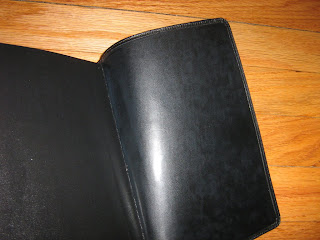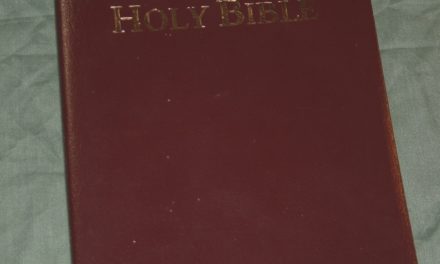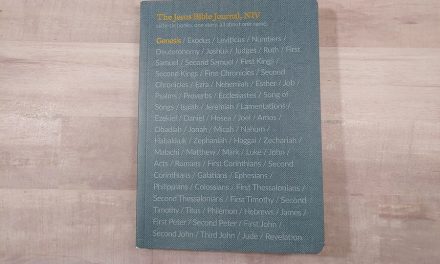Review by Jonathan Ammon of Bible Reading Project
Cambridge University Press has been publishing Bibles since 1591, twenty years before the King James Version existed. This rich publishing legacy has given them a longstanding reputation for choice quality craftsmanship. Their relationship with the King James Bible has lasted for centuries, and their current editions of the KJV reflect not only Cambridge’s classic quality, but also an aged elegance. Cambridge’s KJV Concord Reference Edition in black goatskin showcases Cambridge’s ability to produce an edition which exudes modern elegance with traditional class.
BINDING
The Concord features traditional goatskin leather, which is not only appealing visually and tactilely (and to the sense of smell as well) but is also strong, supple and highly durable. The Concord’s cover stands out as markedly different from the other goatskin editions I’ve handled. It’s suppleness remains about average for goatskin (which is still excellent), but the Concord features a rich, complex grain which is much finer than usual. The difference in the grain is noticeable and gives an organic look and feel to the Bible.
This edition includes two ribbons, a sewn binding and beautiful red under gold art-gilt pages, which have all become standard features of the high quality Cambridge line.
The Concord measures 9 x 6.4 x 1.25 inches, which is an excellent carrying and reading size, though actually smaller than most of the Bibles I’ve reviewed so far (in part because I’m partial to wide margins). Many will find this an ideal size, though my personal preference is to allow thicker spine.
While this is not the most flexible binding I’ve handled there should be few complaints as it handles the yoga position easily. Though some Bibles may display greater flexibility, Cambridge Bibles maintain a strong spine that flexes, but doesn’t fold, which is a sign of greater strength and durability. Bibles that can be easily folded in half display an impressive flexibility, but may do so at the cost of the spine’s longevity.
The Concord features fairly thin paper, though it’s thinness does not compromise its opacity and strength. This is high quality paper, and while it does not seem as strong or as opaque as the paper contained in the Cambridge wide margins, it allows minimal to average ghosting which shouldn’t be a major concern for most readers. Note-taking and underlining should be done with care, though as these pages are not designed for notes and it’s very possible that bleed-through will be significant without the highest quality writing instruments.
The cover features a smooth, high gloss leather lining, which adds another dimension to the look and feel of the leather cover. I have only seen this feature on Cambridge Bibles; it elevates the class and appeal of the cover both visually and tactilely.
LAYOUT
The Concord presents a traditional two column layout in verse per line format with a center column of references. Paragraphs are noted with markers preceding the verse. The topic or theme headings are presented at the top of the page rather than within the text, which I’ve not seen elsewhere. I find this feature preferable as the section titles often flavor the way a text is read; by separating them from the text the reader can choose to ignore them or use them as he or she wishes. The font (Times Semi Bold) has a more old-fashioned style and classic look, stands at a bold and readable 8pt size. The boldness of the text in conjunction with sufficient line spacing create a clear, readable type. The text is available in both black letter (featured here) and red letter format. This layout will please traditionalists, but its narrow columns and small references do not make it an ideal reading Bible. The margins are fairly small and would not allow room for notes beyond small verse references added to the center column or the outside margin. The overall format presents a traditional compromise between functionality for study and reference and functionality for simple reading.
FEATURES
The Concord includes a number of useful and well-executed features, including self-pronouncing text for difficult names a glossary of Biblical usage, a 136 page concordance, a 128 page Bible Dictionary and the always beautiful and excellent Cambridge maps and map index (see my other Cambridge reviews). The self pronouncing text is rarely intrusive and reserved for names that are unusual or difficult to pronounce, while names in common usage are left without pronunciation.
The glossary is similarly useful, especially in the King James Version as a number of words have changed in meaning or have become obscure since 1611. The glossary details the definition of the word as intended by the translators and further gives a number of verse references in order to give example. Some of the changes are actually quite important, for instance, “let” which in the KJV is used to mean “to hinder, prevent.”
The Bible Dictionary is equally useful detailing a number of troublesome terms and important facts and chronologies. Its concise nature makes it useful for study, but does not add a cumbersome weight to the Bible or intrude on the text with footnotes etc. For those who do not want a study Bible, but do desire a quick reference for difficult concepts or questions (such as Abraham’s Bosom), the dictionary is an ideal aid.
In addition to these reference works at the back, the front of the Bible features a dedication page, and pages to record family records, marriages, births and deaths. Also included are the full “Epistle Dedicatory” and “The Translators to the Reader” which are important both historically and philosophically.
The Cambridge Concord reference is a truly beautiful edition, which combines classic study tools with a traditional presentation. The high quality craftsmanship behind the Bible’s exquisite binding make this without a doubt a durable edition that majors on style. For those in the market for a traditional carrying Bible in the KJV, this would be the best of the best. The only shortcoming would be the price, which exceeds most editions considerably. The Concord contains a number of features which elevate it above other editions and the quality of the goatskin cover is a notch above all others I’ve handled, this edition’s value per dollar depends on the consumer’s desire for those small details which combine to place the Concord at a higher level of excellency.
My thanks to Cambridge for providing this free review copy. I was not required to give a positive review, but an honest review.













I feel blessed to land on this website. So many comments reflect what I thought was “only me” regarding nuances of quality for the book containing the Word of God. I am afraid this is not the most favorable comment on the Cambridge Concord KJV in black goatskin. I recently purchased this Bible believing I was getting one of the best quality Bibles I could purchase. I did my research, primarily on this site, and could not wait to receive it. After checking it out for a few days I returned it for a refund. Here is why.
First the good. It had the nicest goatskin cover I have ever felt, perfect size and feel; certainly a high quality Bible. The features were exceptional and I agonized over them before deciding to return it. The concordance was superior, the glossary great, and the dictionary a very valuable feature. Here is what I considered the bad. While the print was so easy and comfortable to read, in too many places there were breaks in a letter (like a chip out of the letter), while for the most part the print was nice and bold it often became noticeably lighter. This was a Red Letter edition. The Red was a nice bold red, but again the boldness too often faded to a lighter shade in many places. I own many Bibles, never this expensive, and have never noticed such flaws. The paper is butter smooth and I had no criticism regarding shadow image. That being said the paper was also so thin and limp that it easily became crinkled when, due to lack of enough body, it would curl in towards the gutter as I flipped through pages. In trying to turn pages it was a delicate task to avoid turning more than one page and care was required to avoid wrinkling the edge of the page. So I decided that this was not a Bible for me. I currently have a large leather Thompson, (wonderful quality) and three LCBP Bibles, a Old Scofield,and two with just text. I also have a Henry Morris KJV Commentary, a 1611 KJV in original text, a 1599 Geneva,a TBS Family text Bible and a Tyndale NT. Of all of these I have never had anything come to my attention to complain about. The Cambridge Concord is the first. To be fair to Cambridge I did not contact them to see how they would respond to my complaint.
I wonder if these complaints of the Cambridge sound rare to others on this site. I would still like a high end Bible and am now considering an Allen Longprimer but I am a bit apprehensive after this experience. I would really appreciate comments others pro or con.
Blessings,
Lee
Hi Lee. Thanks for your comments. You’ve got a good collection. I’ve been interested in the TBS Family text edition. My Concord doesn’t have the issues yours had. I wonder if you could exchange it for a different copy and not have those problems. I like it because it’s the best size for for and has great tools. The Longprimer is one of my favorites. It does have the older style publishing ‘look’ to the text, so you will find a word here and there that is missing a portion. They use a photocopy of the text made around 50 years ago that was pressed into the paper. This leaves blotches and smears. It’s not bad at all, but it is that printing style (like the Concord). The references in the center column can be difficult to read because of this. The regular text looks fine to me. The Schuyler has a cleaner print (it’s a digital font), but overall I like the Longprimer because of the topical index (same as the old Oxford Scofield). I don’t think you can go wrong with either of them.
Randy
Thank you, Randy, for the very helpful reply. I feel a bit of regret on hearing that you have no similar complaints about the Concord. 🙂 Perhaps I should have contacted Cambridge.
I just ordered a TBS Westminster Reference from evangelicalBible after reading about the Westminster type of reference; the Bible explaining the Bible. I thought it was something I want.
Since you mentioned an interest in The TBS Family text Bible I can share, since I have one. It’s a real quality item however I feel it’s lacking, due to not having a concordance. I like having the resource and the extra pages following Revelation that make flipping pages near the end of the book easier. The cover is a bit stiff but beautiful and gives it a very solid feel. You do not have to treat this Bible delicately.
Hi Randy,
I want to add some follow up regarding the negative comments I made about the Cambridge Concord. After your reply I called evangelicalBible and mentioned the problems I reported on. The person told me that there was a bad batch of Red Letter editions some time ago and that Cambridge took back all that came to their attention as defective and replaced them. This makes me feel much better and I will most likely purchase one just because I liked it so much and I want the dictionary that is included.
Any company can have a problem with their product at times for various reasons. To me Cambridge proved their standards are very high when they replaced the few that didn’t measure up.
Thanks for the follow-up. That’s good to know. In my experience with Cambridge they are willing to replace any defective Bible. At this price point I wouldn’t accept anything but the highest quality.
I know this is an old post, but wanted to share my comment. I just received the Concord in Goatskin today. Right away the leather is impressive and limp. To be fair, I am comparing this in competition with my Allan Longprimer, so my expectations are high! It is a smaller format than the Allan, with the lack of yapp causing it to feel smaller than it actually is. (again, compared to Longprimer). The font is easy to read, but I have the same issue that reviewer Lee mentions from 2013. There is a section of lighter print in the O/Testament that is noticeably different than the rest of the Bible. Also there are four pages in Matthew where the printing is way off from lining up front to back…so you see ghosting badly, to the point of distraction. This is a disappointment and casts doubt in the consistency of quality. Just my thoughts, un-professional though they are.
It is a nice format and font, and the leather seems very nice with quality build. Not sure if I will keep it though, due to these print issues. I was hoping this would steal the day for me, then I would get the same format in WMargin for study, which would allow me to have the same pagination in each. They also make the personal size as well…three Bibles, different sizes/uses, all the same pagination. That was the plan…
Hi Brian. Thanks for sharing. I hope you can get one without the issues. The combo is a great idea (you can see mine here). What are the page numbers that you have the most variation in? I’ll check mine to compare.
Much of Proverbs is lighter, pg 760, then in NT 120-133, 225-226. That is just a causal run through. The color is almost grey, not black. There is such variation that you can flip from one section to another and it will catch your eye, from a thick, bold font, to a light, almost grey print. Strange.
Cambridge is sending me another one. We shall see what difference is in this copy. I must say, this goatskin is incredible! I find the grain to be just a perfect balance. It has a thickness, yet buttery soft; which I find more appealing than my Allan Highland. I know this is just personal opinion.
That’s good news! Cambridge is great when it comes to taking care of customers. Your goatskin cover sounds amazing. I’ve never seen the Concord in goatskin. I’ve wanted one for a long time… trying to resist… but failing…
Dear Mr. Brown– I red this article with much interest. I purchased this same Bible in 1998, yet when I got it home I found out that the 9 point print was/is way too small for me and I just packed it away. I wonder if you or anyone else know of anyone who would like to purchase it from me as it is still BRAND NEW and in it’s slipcase. I only removed it to see the print and knew it wasn’t for me. I’ve never used it and the spline is not even broken in. I’ve seen used copies of this Bible for like 300-400-500 dollars and didn’t realize that there were collectors out there. I’d appreciate any thoughts comments or suggestions as I just don’t need it and have never even used it. Thank you Sir and God bless you and yours, Bob
Hi Bob. If you’re on Facebook I recommend posting it to The Bible Exchange. You can see the page here: https://www.facebook.com/bibleexchange/